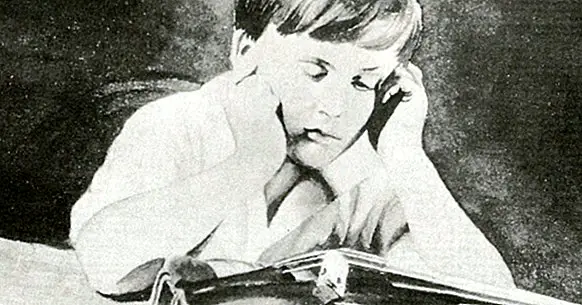Thematic Appreciation Test (TAT): characteristics and operation
Each one of us has his own way of seeing reality, of interpreting it and of acting and being in the world. Each one of us has his own personality. Partly inherited and largely learned, the personality of an individual allows us to know and even predict to some degree how to interact and react to the situations of an individual. And this can have great relevance when it comes to exploring the reasons that cause different subjects to react in different ways to the same situation or that someone continuously manifests behaviors that generate discomfort or that are maladaptive. That is why different mechanisms and tests have been developed to try to assess personality.
One of the numerous existing tests in this sense, of psychodynamic orientation and framed within the projective tests, is the Thematic Apperception Test or TAT .
- Related article: "Projective tests: the 5 most used types"
The Thematic Apperception Test or TAT
Created by Murray in 1935, the TAT aims to be a system for assessing the unconscious needs, expectations and fears that regulate our behavior and that contribute to forming our personality from the interpretation of ambiguous stimuli (considering the author that in that process can observe the presence of personality traits).
It is a projective test or test, the TAT being known among them as the clearest and best known exponent of thematic projective test (which basically has to tell a story from the presentation of one or more sheets). As a projective test of psychodynamic origin, its objective is to analyze unconscious elements of the subject that form and shape their personality to a great extent.
This evaluation has the advantage of being masked, which implies that the subject does not know what is being evaluated or what response can be expected from him and it is more difficult for him to falsify his answers (decreasing the probability of issuing answers based on social desirability ). But nevertheless, does not allow a quantitative analysis but only qualitative , different professionals can obtain different conclusions of its application and not having a single isolated stimulus but its interpretation requires an analysis of the whole.
This projective test consists of a total of 31 plates in black and white, of which all but one represent different scenes structured but ambiguous linked to different themes. Among them, eleven are universal while the rest are divided according to the type of population under study (according to sex and age) in such a way that each subject can at most visualize a score. However, it is not necessary that all be passed, but the clinician will assess if it is valuable to pass only the most relevant depending on the patient in question.
The subject should briefly observe each sheet in order to elaborate from it and the elements that are part of the scene a story, considering first that he sees in the image or scene to later elaborate a brief narration regarding what is happening in it, what has happened before and what will happen next. It will be the interpretation of these stories that will allow us to get an idea of the psychic processes of the analyzed subject.
- Maybe you're interested: "Types of psychological tests: their functions and characteristics"
Interpretation
The TAT results do not have a single possible interpretation , as it is not a standardized test that reflects specific scores. Its evaluation requires high doses of intuition and clinical judgment, with the information extracted from a qualitative type. It does not allow to establish a diagnosis, but to observe the patient's way of seeing things and how they structure them.
Although there are different systems of classification and interpretation of results, these depend to a large extent on the objectives of the analysis of the patient's personality. For example, the Manual of Defense Mechanisms proposes to assess the existence of denial, projection and identification as defense mechanisms against psychic conflicts, which would be projected in the stories. Regardless of the method of interpretation, two main factors are taken into account in almost all cases: on the one hand the content of the narrative and on the other the way in which the story is structured or formed .
Content
When assessing the content of the story, the creator of the test considered that it was necessary to take into account six main aspects.
The hero or protagonist of the story is one of these elements. In those sheets with more than one character, it is the subject with which the patient identifies and in which the story is centered.It is usually the one that has more resemblance to the patient itself. Keep in mind that the sheets themselves do not clearly indicate the existence of a main individual, being the subject who chooses it. Likewise, it is observed if the patient chooses a single protagonist or he changes during the discourse or if he chooses a group, animal or object as such.
It also has to be valued the existence of different qualities in said protagonist and the role it has in the narrative (it's good / bad, active / passive, strong / weak ...). The one with whom he identifies himself and as said character informs us of the self-concept of the patient analyzed.
Another point to highlight, linked to the previous one, is the motivation and the needs of the hero . How he feels or what he wants or motivates him internally to act as he does. Protecting loved ones, hate or love, or what makes you feel the events are part of this aspect. It is also associated with the objectives and goals themselves.
The third key point is the pressures to which it is subjected, or what happens to the subject and that can mark its way of acting. Here it is possible to assess possible worries or stressful or traumatic situations that are affecting the patient's life.
The environment is the fourth of the main aspects to assess. The patient must interpret not only the hero and what happens to him but also assess the situation in which he finds himself. The environment and the relationship with the other characters, or how are these characters or the roles they fulfill (are family, couple, friends, enemies, threats, mere witnesses ...), are great examples. Can inform about the way of relating to the environment and the perception of it by the patient .
The fifth of the elements to value is the development of history itself. How events happen, how they begin and how they end. This, of course, can be related to the patient's actual expectations regarding his own self-efficacy and his mood.
The last but not least important point of analysis is the theme of the story, which tend to be linked to the concerns and concerns of the patient . For example, someone depressed and / or with suicidal ideas will tend to reproduce elements linked to death, or someone obsessed with cleanliness and germs with diseases.
Form of the story
In addition to what the patient says, it is relevant how he says it and the degree of involvement shown in the activity. Whether the patient collaborates or not, if he correctly perceives the images and understands what he should do or if he has sufficient capacity for visualization and elaboration are remarkable aspects that can indicate the presence of resistance or difficulties associated with a particular problem ( as well as assess whether the test is indicated or not).
Already within the story itself, it is necessary to take into account if there is coherence, linearity, contradictions , whether fantasy or realism is used or not, if you use many or few adjectives or if you give details.
Bibliographic references
Murray, H. (1973). The Analysis of Fantasy. Huntington, NY: Robert E. Krieger Publishing Company ..
Sanz, L.J. and Álvarez, C. (2012). Evaluation in Clinical Psychology. CEDE Preparation Manual PIR, 05. CEDE: Madrid



















